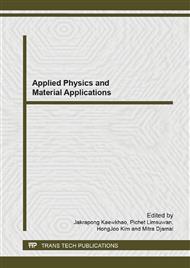[1]
J. Nagamatsu, N. Nakagawa, T. Muranaka, Y. Zenitani, and J. Akimitsu, Superconductivity at 39 K in magnesium diboride , Nature. 410 (2001) 63-64.
DOI: 10.1038/35065039
Google Scholar
[2]
S. L. Bud'ko, G. Lapertot, C. Petrovic, C. E. Cunningham, N. Anderson, and P. C. Canfield, Boron Isotope Effect in Superconducting MgB2, Physical Review Letter. 86 (2001) 1877-1880.
Google Scholar
[3]
B. A. Glowacki, M. Majoros, M. Vickers, J. E. Evetts, Y. Shi and I. McDougall, Superconductivity of powder in tube MgB2 wires, Superconductor Science and Technology. 14 (2011) 193.
DOI: 10.1088/0953-2048/14/4/304
Google Scholar
[4]
C. Buzea and T. Yamachita, Review of the superconducting properties of MgB2, Superconductor Science and Technology. 14(11) (2001) R115.
Google Scholar
[5]
V. Moshchalkov, M. Menghini, T. Nishio, Q. H. Chen, A.V. Silhanek, V.H. Dao, L. F. Chibotaru, N. D. Zhigadlo, and J. Karpinski, Type-1.5 Superconductivity, Physical Review Letter. 102 (2009) 117001.
DOI: 10.1103/physrevlett.102.117001
Google Scholar
[6]
E. Babaev and J. Carlstrom, Type-1.5 Superconductivity in two-band systems, Physica C: Superconductivity. 470(19) (2010) 717-721.
DOI: 10.1016/j.physc.2010.02.025
Google Scholar
[7]
A. Changjan and P. Udomsamuthirun, The critical magnetic field of anisotropic two-band magnetic superconductors, Solid State Communications. 151(14-15) (2011) 988-992.
DOI: 10.1016/j.ssc.2011.04.032
Google Scholar
[8]
I.N. Askerzade and A. Gencer, London penetration depth (T) in two-band Ginzburg-Landau theory: application to MgB2, Solid State Communications. 123(1) (2002) 63-67.
DOI: 10.1016/s0038-1098(02)00214-4
Google Scholar
[9]
C. Panagopoulos, B. D. Rainford, T. Xiang, C. A. Scott, M. Kambara and I.H. Inoue, Penetration depth measurements in MgB2: Evidence for unconventional superconductivity, Physical Review B. 64, (2001) 094514.
DOI: 10.1103/physrevb.64.094514
Google Scholar
[10]
A. V. Pronin, A. Pimenov, A. Loidl, and S. I. Krasnosvobodtsev, Optical conductivity and penetration depth in MgB2, Physical Review letter. 87, (2002) 097003.
Google Scholar
[11]
X. H. Chen, Y. Y. Xue, R. L. Meng and C. W. Chu, Penetration depth and anisotropy in MgB2, Physical Review B.64, (2001) 172501.
Google Scholar



